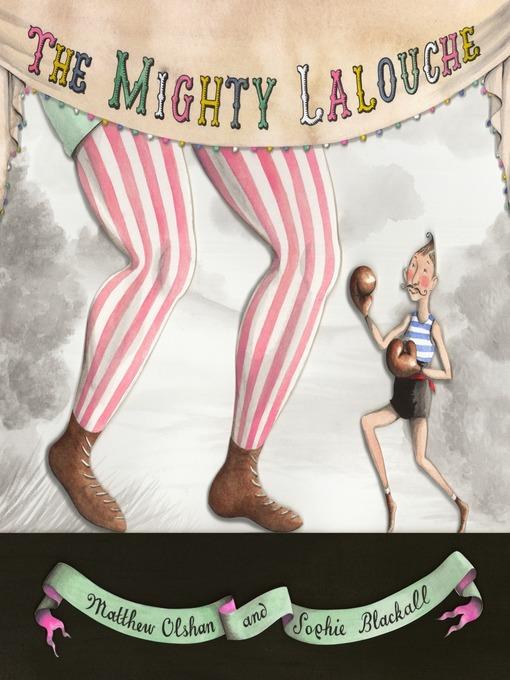
The Mighty Lalouche
فرمت کتاب
ebook
تاریخ انتشار
2013
Lexile Score
690
Reading Level
2-3
ATOS
3.7
Interest Level
K-3(LG)
نویسنده
Sophie Blackallشابک
9780375987427
کتاب های مرتبط
- اطلاعات
- نقد و بررسی
- دیدگاه کاربران
نقد و بررسی

Starred review from March 11, 2013
Lalouche does not start out mighty in the least. A humble postman in 19th-century Paris, “He was small, Lalouche, and rather bony,” writes Olshan (Finn), whose effortless prose has a giddy Gallic lilt throughout. And yet, Lalouche’s “hands were nimble, his legs were fast, and his arms were strong,” qualities that serve him well when he is replaced on his route by an electric autocar and instead finds employment as sparring partner at the Bastille Boxing Club. Soon, the wiry, speedy Lalouche is a boxing champion and the toast of tout-Paris, vanquishing such deliciously named foes as the Anaconda, the Pointillist, and the Misanthrope. It’s easy to imagine a book about an unprepossessing civil servant and the belle epoque craze for la boxe française as having a rarified appeal at best, but Olshan and Blackall (Edwin Speaks Up) have created a bona fide knockout. Lalouche is an endearingly oddball hero, and Blackall takes her always-exquisite ink-and-watercolor artwork to another level, creating three-dimensional cut-out scenes that have the intensity of silent film and the magic of an exquisitely crafted toy theater. C’est formidable! Ages 4–8. Illustrator’s agent: Nancy Gallt, Nancy Gallt Literary Agency.

April 1, 2013
K-Gr 3-Lalouche is a Parisian postman living more than 100 years ago. Though diminutive, he is blessed with strong arms, nimble fingers, and fast legs. When he is sacked, thanks to the invention of an electric automobile, he must find a way to support himself and his beloved pet finch, Genevieve. Desperate, Lalouche joins the Bastille Boxing Club. Because he is so small, he is repeatedly underestimated as he continues to win matches against much bigger opponents, including gigantic Anaconda. It is when he fights "for country, mail, and Genevieve" that readers learn, "one should never underestimate a man who loves his finch." The story, along with the language, is entertaining; names like Diamond Jacques and the Grecque, and words like "tomfoolery," will keep readers and listeners amused. Some French is sprinkled throughout, e.g., "C'est impossible," and a glossary helps with translation. The illustrations are outstanding-Blackall has outdone herself. The ink-and-watercolor artwork was cut out, arranged in layers, and photographed, resulting in an eye-catching, textured, three-dimensional effect that children will love poring over. The text and pictures work expertly together, moving the story forward in clever and funny ways; Lalouche's facial expressions alone should elicit giggles from readers. An author's note about the history of French boxing and the invention of the electric car further enhance this captivating tale with a wonderful moral: small people are capable of great feats.-Laura Lutz, Pratt Institute, New York City
Copyright 2013 School Library Journal, LLC Used with permission.

April 1, 2013
While he has no difficulty overcoming much larger and fiercer opponents in the boxing ring, the eponymous hero of this quirky collaboration may nonetheless struggle to find an appreciative audience. Lalouche is a postman in late-19th-century Paris. Slight but strong, he enjoys his work, adores his pet finch, Genevieve, and appreciates his small apartment, even if it doesn't have a view. Naturally, he is devastated when his superior informs him that he's being replaced. Determined to find work, he responds to an advertisement for sparring partners, and the rest is history (though there's a bit of mockery to endure before he triumphs). Luckily enough, the postal service's new "fleet of electric autocars" don't work out as expected, so by the happy ending, Lalouche is back to pounding the pavement and chatting with old friends on his regular route. Olshan's understated text flows smoothly, with occasional French phrases that emphasize the continental charm of his offbeat narrative. Blackall's ink-and-watercolor illustrations, meanwhile, combine exaggerated size differences and unusual angles with a collagelike style to create a gently humorous, old-fashioned, scrapbook feel. Illustrations of Lalouche's opponents are particularly amusing, including those that decorate the endpapers. Blackall's personal collection of pictures of old-time boxers apparently inspired Olshan's narrative; though thoroughly accomplished, it nonetheless has a very adult feel. It remains to be seen whether young listeners will consider Lalouche a real contender. (author's note) (Picture book. 6-8)
COPYRIGHT(2013) Kirkus Reviews, ALL RIGHTS RESERVED.

Starred review from June 1, 2013
Preschool-G *Starred Review* In Paris, at the turn of the last century, lived a postman named Lalouche. Skinnybut nimblebonybut with strong armshe resides with his finch, Genevi've. One day Lalouche turns up at the post office only to learn that an electric auto will replace him on his route. Mon dieu! Who will pay for his rented room? How will he feed Genevi've? When a poster for a boxing club catches his attention, Lalouche has an idea. He shall become a boxer! The club manager is dubious, but what Lalouche lacks in strength, he makes up for in his ability to twist, turn, leap, and squirm. Soon he has beaten the burly stars of the ring: the Anaconda, the Grecque. But when the electric cars prove a bust, he is thrilled to return to his job as postman. The text is more action-packed idea than story, but it neatly serves its purpose as a vehicle for Blackall's amazing artwork. The illustrations, made with Chinese ink and watercolors, are cutouts arranged in layers and then photographed. This gives the spreads a 3-D look, with the effect being more of looking at a diorama than a page in a book. Wonderful details abound, from the expressions on the boxers' faces to the finch flying around the ring. The final scene of Lalouche on the balcony of his new Paris apartment is a delight artistically and emotionally. But we're not quite done: the endpapers feature posters of France's most powerful pugilists in all their punchy glory. Tr's bien!(Reprinted with permission of Booklist, copyright 2013, American Library Association.)

























دیدگاه کاربران